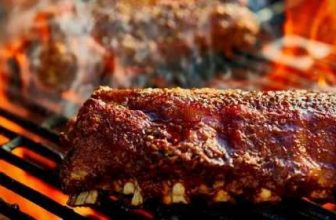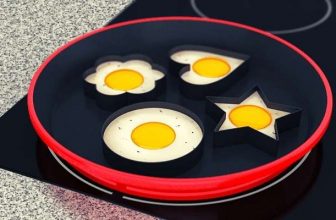Induction ranges use a magnetic field to create heat, while electric ranges use wire coils. Most people can tell the difference by feeling. Electric ranges tend to be hotter at the front and cooler at the back, while induction ranges are more even in temperature.
Any electric hob that works with many pots and pans is most likely a standard electric hob.
Make sure the pans are magnetic if you’ve just moved and the job isn’t running. Using a refrigerator magnet, check the bottom of your pan; if it doesn’t stick, your pan isn’t compatible with your induction hob.
Moreover, there are several ways to determine if you have an induction or electric cooktop. The first way is to look at the plug. If your cooktop has a three-pronged plug, it is an electric cooktop.
If your cooktop has a four-pronged plug with a slight circular indentation in the center, it is an induction cooktop.
Best Induction Cookware Sets: Buying Guide 2021The Difference Between Electric And Induction Cooktops
Excellent addition to any kitchen, a cooktop is versatile enough to fit any space. Any kitchen would benefit from a countertop, whether you have a built-in oven or not.
Gas, electric, and induction cooktops are the most common, but others. If you’d like to know which is most suitable for your kitchen and lifestyle, please read on.
Electric Cooktops
Electric cooktops don’t use a flame for cooking food. To heat the cooktop, electric coils are used. These cooktops are better at maintaining low heat than other types.
Coil cooktops and smooth top cooktops are the two options for electric cooktops.
Coils are placed on the cooktop or recessed into the cooking surface. Spills are more likely to damage the coils, but drip pans placed beneath them will catch most of them. They’re also the most affordable.
Radiant elements, like coils, are installed beneath a smooth, easy-to-clean glass surface on these cooktops. Elevators with smooth top features provide a consistent and rapid heat source. As an added benefit, they give the impression of being well-coordinated.
Pros And Cons Of Electric Cooktops
Pros
The electric cooktop isn’t quite as trendy as the induction cooktop, but that’s alright.
They remain pretty popular for an excellent reason even though they have been around for quite some time;
- Easy to use and straightforward to install, and reliable and precise.
- Easy to use, so learning is unnecessary.
- Stovetops stay warm after they are turned off. The excess heat you are generating can be used to keep your food warm before serving it.
Cons
- Using a smaller pan than the surface being heated may cause uneven heat or waste lots of energy.
Induction Cooktops
An induction cooktop uses a complex series of electromagnetic coils to create a magnetic field. This field causes currents of electricity to flow through the pan on the cooktop. The currents create heat, which cooks the food.
Induction cooktops are a relatively recently developed technology growing in popularity in recent years. They use a magnetic field rather than heating the air around it like a traditional gas or electric stove. They will also stay hot for longer after turning them off, making them more efficient and faster to heat up.
Magnets are installed on the bottom of the cooker to use the cookware with the magnets. For busy households, they’re a better choice because they only heat the cookware’s surface that is in contact with it.
Pros And Cons Of Induction Hobs
Cons
With an induction cooktop, you can cook in a variety of ways. One of the most significant benefits is that they consume less energy. Induction cooktops are estimated to deliver 90 percent of electromagnetic energy directly to the food in the pan. This is compared to gas ranges which only provide 38 percent.
Speed
An induction hob heats up fast! The pan itself receives all of the heat instead of the ring, so they warm up quickly and can even boil modest amounts of water faster than a kettle! As with a gas hob, you have a similar degree of control.
Responsive
Gas hobs cannot compete with the responsiveness of induction stoves. An induction hob cools the pan down as soon as you turn the heat back on because the heat is directly in the pan. Therefore, you never have to worry about pasta splashing water all over the stove!
Energy Efficiency
No one can claim that induction hobs would be more energy-efficient than gas or electric stoves.
There’s barely any energy wasted if you have an induction hob. However, the entire kitchen may heat up using gas hobs, and that’s all wasted money and power that should be used in the pan!. On an induction hob, you can use any ring for almost any size pot and pan, and you’ll get the heat you desire.
Easy To Wash
Unlike gas and conventional electric hobs, induction hobs have level surfaces and are quick to cool.
User Friendly
Using suitable pots and pans will make induction cooking a joy and a staple in your home.
The surface of the pots doesn’t even have to be placed on a ring for the heat to spread evenly. This enables you to use more pans on the outside and heat food, making induction hobs suitable for cooking Christmas dinner or other substantial family meals!
Cons
- Induction cooktops have one downside: they are expensive. They tend to be more expensive, which can be a problem.
- Since induction ceramic hobs have particular electrical requirements, they require an electrician to match them. As a result, induction hobs are generally more costly.
The Mechanics Of Induction And Electric Heat
Although electric and induction cooktops produce the same results, how they accomplish it is vastly different. An electric cooktop uses a central heating source. Metal coils are heated with an electrical current beneath the glass or ceramic surface of the cooktop.
Traditionally, electric stoves have a glass or ceramic cooking surface with heating elements underneath.
After the coil gets hot, it glows and radiates heat to the surface through infrared energy. During cooking, that energy heats the surface of the burner evenly. The heat is transferred to a pot as soon as it is placed on the surface and then to the food inside. The process is called thermal conduction.
Copper coils are used in induction cooktops, which produce a magnetic field when a pot or pan is placed on it. With induction cooktops, the cookware itself is heated directly instead of the surface, and the cookware passes heat along. Thus, a pot or pan will be evenly heated, and heat will be lost much less during the cooking process.
Best Electric Smokers For 2021 | Types And Buying GuideFAQs
What Is An Induction Hob?
As I mentioned earlier, an induction hob operates differently from a conventional hob. A ceramic hob heats the pan straight up, unlike an induction hob; a ceramic cooktop heats a ring, then heats the pan.
The induction hob works by using magnets instead of electricity. Therefore, when you set your pan on the hob, the magnetic field associated with the pan is triggered under the hob’s surface.
When the pan is on the hob, the circuit has been completed, and the hob is also warming up. However, the induction hob won’t heat the element if the pan isn’t magnetic.
Do Induction Cooktops Scratch Easily?
It’s easy and practical to clean induction cooking with induction hobs, which are energy-efficient. However, this does not mean that the surface is more resistant to scratches and stains. After use, we recommend wiping down the hobs with a soft, damp cloth.
Consider purchasing a scratch remover product if you have noticed the cooking surface needs a shine. Since induction hobs typically have an outer surface made of steel or plastic, they are usually durable and will not scratch easily. Meanwhile, the induction stovetop layer is durable glass and retains heat well but can be scratched.
Use soft fabrics which are appropriate for hobs and avoid any offensive materials. Furthermore, our recommendation is to choose magnetic pans with sleek, flat bases to prevent scratches. The magnetic pans are easy to find, and most of them have been manufactured in this way.
How Can You Distinguish Induction Cooktops From Electric Cooktops?
Induction and electric cooktops consist of coiled metal elements beneath a ceramic surface, heated electronically to the desired temperature.
An induction cooker produces heat that prepares the pan for induction cooking. Electromagnets are used instead of metal coils with an induction cooktop to heat the pan directly.
Which Is Better Electric Stove Or Induction?
Electric stoves are much more reliable and long-lasting. They come with fewer issues (such as rust) and can also be cleaner. However, induction stoves can be cheaper to use.
You may not need a separate pan or plate to cook on, making them simpler and quicker to use. Induction stoves require no gas. You can choose between convection or conduction. The latter heats the entire stove, making it very slow to heat up.
How long Do Induction Cooktops Last?
An induction cooktop has three main parts: an induction coil, electronic controller box, and heating element. The induction coil converts electrical energy into electromagnetic energy that heats an attached pan.
The control box is where you choose between cooking on the induction burner or an electric range. And the heating element is an electric resistance coil that runs hot when current flows through it. When one of these components fails, replacing it can be expensive and a significant undertaking.
How Do Electric Cooktops Work?
Induction cooktops are a type of cooktop that uses electromagnetic induction. When magnetic coils inside a pan are energized by electricity, they create a strong magnetic field. This strong magnetic field causes the metal in the pan to vibrate, which in turn causes the liquid in the pan to heat up.
An induction cooktop is more efficient than a conventional cooktop because it heats both the cookware and the food evenly. An electric cooktop typically uses electricity to generate heat and run fans to remove the heat.
How Do Induction Cooktops Work?
An induction cooktop works by transferring energy through a magnetic field. It can’t heat anything directly, but instead, it converts electromagnetic energy from the cooking unit into thermal energy transferred to the food.
Induction cooktops have a cooking surface that acts as an antenna. This antenna receives an oscillating current from the power cord and creates a magnetic field, like a magnet drawing iron filings. Electricity is transmitted to the cooktop by the power source.
Therefore, Hence, there are several ways to determine whether your stove is electric or induction. A furnace must be chosen according to your lifestyle and needs.
Using a magnet to check if your pots and pans adhere to the bottom of an induction stove is another way to find out if it is an induction model. In more detail, I have described this above.
How To Use An Electric Smoker ? | 10 Simple Steps







